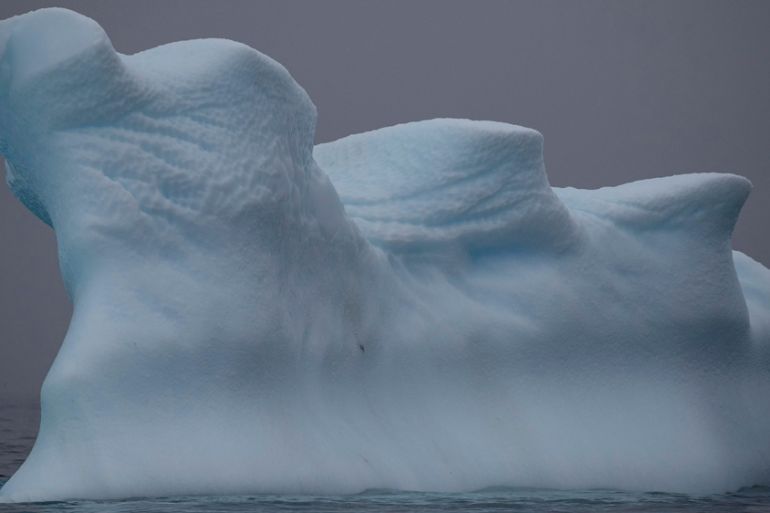Possible new record as Antarctica temperature soars
WMO seeks to obtain data after scientists on Seymour Island log temperature of 20.75C (69.35 Fahrenheit).

Antarctica‘s temperature has reached a record-breaking high of more than 20 degrees Celsius (68 Fahrenheit), according to a team of researchers.
“We’d never seen a temperature this high in Antarctica,” Brazilian scientist Carlos Schaefer told the AFP news agency on Friday, referring to the 20.75C (69.35F) temperature recorded on February 9 on Seymour Island, part of an archipelago off the northern tip of the continent
Keep reading
list of 3 itemsMelting away: Antarctica ice loss increases six-fold since 1979
Let’s stand up for Antarctica
The reading is almost a full degree higher than the former record of 19.83C (67.69F) taken on Signy Island in January 1982.
In a statement, the World Meteorological Organization (WMO) said it was aware of the report but warned that it was premature to say that Antarctica had exceeded 20C for the first time.
“We first need to analyse the very important station metadata, e.g., location, type of equipment, measurement practices, calibration of the instruments, etc, from the researchers involved,” said Randall Cerveny, WMO’s Weather and Climate Extremes rapporteur.
“Once we have those data, we can begin a formal evaluation as to the observation’s validity.”
For his part, Schaefer, who works on Terrantar, a Brazilian government project that monitors the effect of climate change across more than 20 sites in the Antarctic, also cautioned that the reading “has no meaning in terms of a climate-change trend” because it is a one-off temperature and not part of a long-term data set.
“We can’t use this to anticipate climatic changes in the future. It’s a data point,” said Schaefer, a soil scientist. “It’s simply a signal that something different is happening in that area,” he said.
The Seymour Island reading is significantly higher than the 18.3C (64.94F) temperature logged on February 6 at the Argentinian Esperanza research base. WMO said it was also working to verify that reading.
The Antartic Peninsula is among the fastest warming regions of the planet, almost 3C (37.4F) over the last 50 years, according to WHO.
‘Accelerating rate’
Roughly twice the size of Australia, Antarctica experiences average annual temperatures ranging from about 10C (50F) on the coast to minus 60C (140 F) at the highest part of its interior, according to WMO.
Its vast ice sheet contains 90 percent of the world’s fresh water, enough to raise sea level by approximately 60 metres (196 feet) were it all to melt.
Accelerating melt-off from glaciers, and especially ice sheets, in Antarctica is helping drive sea level rises, threatening coastal megacities and small island nations.
“We know that the ice sheet is beginning losing mass, that means it’s melting and that meltwater is contributing to sea level rise,” Tim Naish, of Victoria University of Wellington, told Al Jazeera.
“It’s doing that with an accelerating rate and we expect that to continue.”
According to the United Nations, the past decade has been the hottest on record with 2019 the second-hottest year ever, after 2016. This year seems set to keep the trend as last month was the hottest January on record.
![A chinstrap penguin colony in front of a glacier on Elephant Island in Antarctica [Christian Aslund/Greenpeace]](/wp-content/uploads/2020/02/d4549eb624a840619e1779b971e9bcc2_18.jpeg)
Meanwhile, a group of scientists on a Greenpeace expedition reported this week a drastic reduction in the many colonies of chinstrap penguins, with some falling as much as 77 percent since last surveyed almost 50 years ago.
“While several factors may have a role to play, all the evidence we have points to climate change as being responsible for the changes we are seeing,” said Heather J Lynch, associate professor of ecology and evolution at New York’s Stony Brook University, and one of the expedition’s leads.
Dyan deNapoli, the award winning author of The Great Penguin Rescue, concurred.
“The number one threat to nearly all penguin species today is global warming,” she told Al Jazeera.
And humans should be concerned with the drop in penguin numbers, according to the author.
“The dramatic decline we’re seeing in their numbers is an indication that the overall health of the ecosystem they inhabit is also in decline,” deNapoli said.
“More simply stated, if penguins are dying, it means our oceans are dying. Which ultimately will impact other species, including humans.”